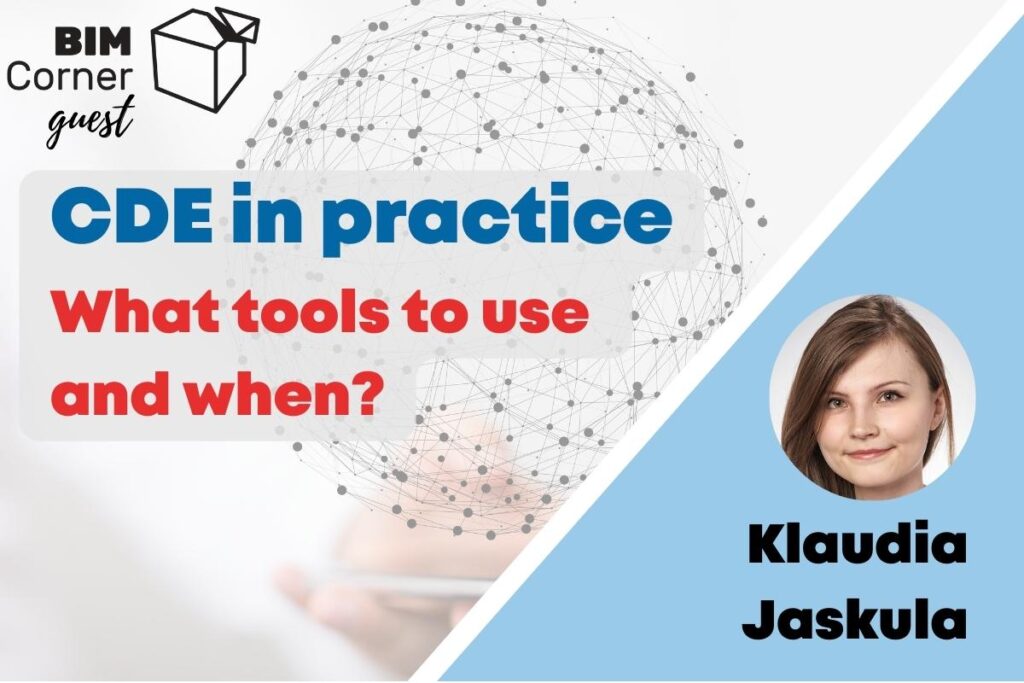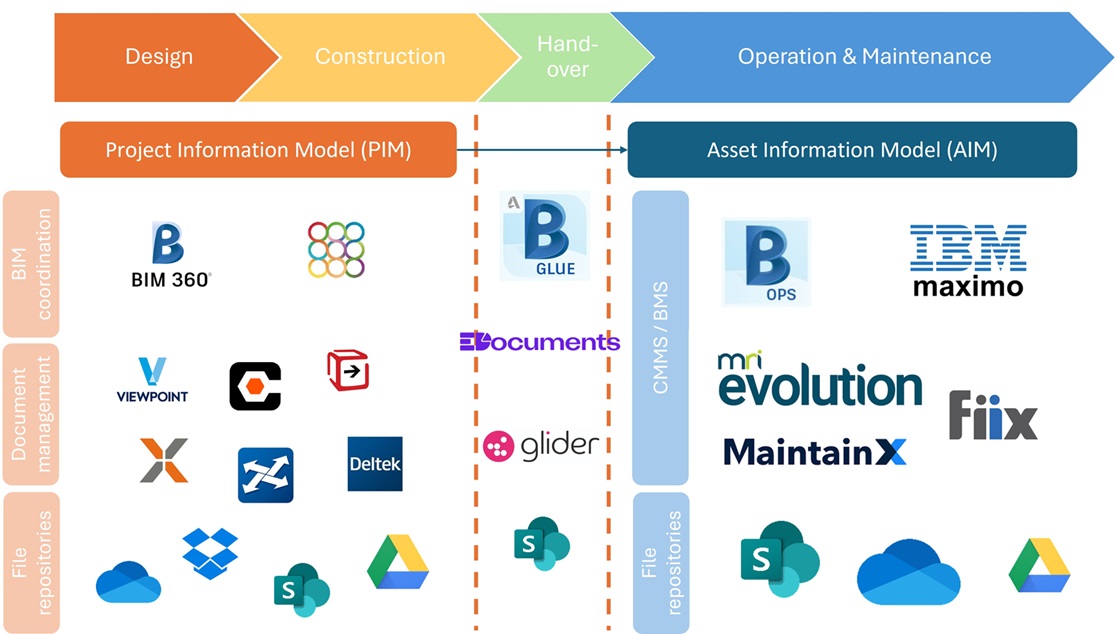Construction projects typically involve a wide range of stakeholders who communicate throughout several phases of the project lifecycle. Unavoidably, this process generates a massive amount of data and therefore effective management of information is crucial for every construction company. A CDE aims to provide all relevant data in a single source of truth, facilitating seamless information sharing, and fostering continuous collaboration between all parties involved. This article will present the tools that can be used as a CDE in all phases of a built asset’s lifecycle.
This post was written by BIM Corner’s Guest Author, Klaudia Jaskula.
Table of contents
CDE definition
According to ISO 19650, entire information exchange in construction projects should be facilitated by a Common Data Environment (CDE) for sharing and coordinating information to enable a consistent information exchange for all organisations involved in a project. CDE is defined in the standard as “an agreed source of information for any given project or asset for collecting, managing, and disseminating each information container through a managed process” [1]. A CDE could mean both a “CDE solution” or a “CDE workflow” [2]. The “CDE solution” is a server-based or cloud-based repository that supports the CDE process by providing database administration, problem tracking, and similar features. A CDE Workflow organises the flow and management of information over an asset’s entire life cycle through the use of four Information Container States: work in progress (WIP), shared, published, or archived. You can read more about CDE workflow here and about CDE requirements and functions here.
CDE classification
Currently, there are multiple tools and solutions available on the market that can be used as a CDE, starting with simple cloud-based repositories such as Google Drive or Dropbox and ending with complex CDE solutions from software providers like Autodesk and Oracle. In my previous work [3], I conducted a series of interviews and surveys to find out what are the most popular solutions and what are their strengths and weaknesses. I also proposed a comprehensive framework to evaluate the development level of CDE platforms, as shown below.
In the framework, features related to document coordination, and communication, have been combined into a single axis related to document management. BIM integration is a distinct aspect of CDEs that is separate from document management functionalities and is therefore identified as the second axis. Security is essential in digital collaboration and has been included in the framework as the third axis of CDE development. The final axis pertains to the lifecycle functionalities that allow the use of CDE in various lifecycle phases of a built asset. The information lifecycle in construction projects can be separated into two stages: information delivery and information operation. The former covers data from the project’s initiation through its design and construction phases, resulting in the creation of PIMs (project information models). The latter encompasses data from the operation and maintenance (O&M) phase of the built asset, leading to the production of AIMs (asset information models) [1]. Ideally, a CDE solution should allow tracking of the information along the whole lifecycle of a built asset, however it is rarely a case in practice.
Design and construction CDE tools
In construction project management, the selection of appropriate digital platforms plays a pivotal role in streamlining operations and enhancing collaboration. Below, I will present a comparison of the most popular CDE solutions. Please note, that the list is not comprehensive and that the information about each solution was gathered through a series of interviews and surveys which were a part of my PhD research and show a status as of mid-2023.
BIM 360
Among the various tools available, BIM 360 from Autodesk stands out as a widely adopted solution. Offering direct synchronization with popular BIM software like Revit and Navisworks, BIM 360 facilitates real-time collaboration within shared BIM models. However, despite its advantages, some practitioners have reported limitations with BIM 360. For instance, while it excels in certain areas like RFI management, it lacks suitability codes, necessitating manual input and potentially leading to inefficiencies. Consequently, alternatives like Aconex or Viewpoint, have been used to complement these inefficiencies.
Aconex
Aconex developed by Oracle offers advanced version control, data immutability, and a unique data ownership model. Its classification of suitability status and revision control streamline information tracking, although concerns about interoperability have been raised.
Viewpoint4Projects
Viewpoint4Projects, a tool from Trimble, also commands a significant presence in the CDE landscape. Although perceived as basic and somewhat outdated, it excels in document management, particularly for revision and sign-offs, making it a preferred choice for document controllers, project managers, and design managers.
ProjectWise
ProjectWise from Bentley presents advanced document management functionalities integrated with Microsoft 365 products. While user reviews highlight its robust features, the learning curve and potential slow data transfer are its main drawbacks.
Other
Less-utilized platforms such as Deltek and Procore offer similar document management and BIM functionalities but may suffer from compatibility issues and instability, respectively.
Despite the availability of specialized CDE tools, many stakeholders lean towards simpler solutions aligned with existing workflows. Widely used cloud-based file repositories like Dropbox, Google Drive, and Microsoft SharePoint offer convenient data-sharing capabilities, albeit with compromises in security and interoperability.
In conclusion, while dedicated CDE platforms offer specialized functionalities tailored to construction project needs, the adoption of simpler solutions underscores the importance of integration with existing practices and ease of use for stakeholders across the industry.
Handover and O&M tools
In transitioning from the design and construction phases to the operation and maintenance (O&M) phase of a built asset, the landscape of information management undergoes notable shifts. While systems like CDEs are instrumental in earlier phases, the tools utilized for O&M phase management, such as Computer-Aided Facility Management (CAFM) and Computerized Maintenance Management Systems (CMMS), offer distinct requirements and functionalities.
Unlike their counterparts in design and construction, CAFM and CMMS systems are tailored to address the specific needs of asset management in the O&M phase. Insights from industry practitioners underscore the multiplicity of information sources utilized concurrently in this phase. For example, tools such as Cylon and Concept Evolution can be used for Building Management System (BMS) and CAFM functionalities. Additionally, Autodesk’s BIM 360 Ops was mentioned, albeit with reservations regarding its efficacy compared to established CAFM tools.
Facilitating the seamless transition of information between design/construction and FM systems requires specialized tools. Platforms like Springboard, gliderBIM, and Autodesk BIM 360 Glue serve this purpose, offering capabilities for gathering and managing handover data.
Springboard, provided by eDocuments, streamlines data gathering for handover, offering automation features and compatibility with various data formats. However, its integration with CDEs like Aconex remains limited.
GliderBIM, a newcomer in the market, boasts comprehensive information management capabilities across the asset lifecycle. Its integration capabilities with CAFM, EDMS, and BMS systems via API offer promise, although practical user feedback remains scarce.
Autodesk’s BIM 360 Glue facilitates a direct link between design/construction and O&M phases, streamlining handover processes. Despite its efficiency, challenges persist, with some clients lacking proper CAFM systems, and resorting to manual data gathering for example via SharePoint repositories.
In essence, while CDEs serve as foundational tools in earlier phases, the transition to the O&M phase necessitates the adoption of specialized systems tailored to the unique requirements of asset management. As the industry continues to evolve, the integration and interoperability of these tools will be critical in ensuring seamless information exchange across the asset lifecycle.
Challenges of using CDEs in practice
While recent CDE platforms provide very advanced functionalities, they still fall short of serving as a single source of truth for the entire lifecycle of a built asset [4]. Stakeholders have reported that no single platform can encompass the full range of functionalities required across different lifecycle phases. Moreover, within each phase, stakeholders often utilize multiple tools simultaneously to cater to their diverse needs and preferences.
One of the primary challenges faced is the lack of interoperability between these tools, compounded by the fact that they are provided by different vendors. This fragmentation makes the transfer of data between tools cumbersome, particularly during critical phases like handover between construction CDEs and facility management platforms.
While some opt for basic cloud storage solutions like Dropbox or SharePoint, these fall short of being complete CDE solutions. Research has shown that they lack essential functionalities and security measures required for BIM-based collaboration [5]. However, their simplicity and cost-effectiveness make them popular among small and medium-sized enterprises (SMEs) managing less complex projects.
Even more sophisticated systems like BIM 360 or Aconex, while partially fulfilling Level 3 CDE criteria, do not consistently excel across all four areas. While they offer robust document management functionalities and integration with BIM models, they may not support BIM editing within the software itself. Similarly, collaborative BIM systems like Autodesk BIM 360 may not meet BIM security standards due to reliance on cloud service providers.
Achieving a full Level 3 CDE across all lifecycle phases remains elusive in the current market landscape. While many tools claim compliance with ISO 19650 standards, none function as a singular source of truth throughout the entire building lifecycle. Developing such a comprehensive tool is deemed impractical, prompting software vendors to focus on developing suites of tools tailored to specific lifecycle phases. However, this approach necessitates stakeholders to invest in multiple products from the same suite, posing challenges in practical implementation.
In essence, while advancements have been made in CDE development, the fragmented nature of the industry and diverse stakeholder requirements continue to pose challenges in achieving seamless information management across the building lifecycle. These challenges were recognised by emerging software providers such as BIMlauncher and Newforma which provide data integration between multiple CDE solutions.
Conclusions
In conclusion, effective information management is paramount for the success of construction projects, given their complexity and the volume of data generated over their lifetime. Common Data Environment (CDE) solutions serve as the foundation for this management in BIM-based project delivery. This article analyses the tools currently used as CDEs and their practical implementation, shedding light on their shortcomings and advantages.
CDE maturity can be classified into three levels, considering aspects like document management, BIM integration, security, and lifecycle functionality. While basic cloud repositories like Dropbox are categorized as Level 1 CDEs, more advanced tools such as Viewpoint, Asite, Procore, Deltek, or ProjectWise fall into Level 2, offering enhanced BIM integration alongside document management functionalities. Meanwhile, platforms like BIM 360 from Autodesk or BIMcollab provide Level 3 BIM integration, particularly favored for real-time BIM collaboration in multi-disciplinary settings. However, they may not excel in document management functionalities, like for example Aconex or Viewpoint do. This leads to the use of multiple tools in construction projects to meet diverse user requirements.
This post was written by BIM Corner’s Guest Author, Klaudia Jaskula.
Bibliography
1. BSI (2021) Organisation and digitization of information about buildings and civil engineering works, including building information modeling (BIM). Information management using building information modeling. Part 1: Concepts and principles. British Standards Institution
2. BIM Dictionary (2020) Common Data Environment (CDE). https://bimdictionary.com/en/common-data-environment/2. Accessed 12 Dec 2022
3. Jaskula K, Papadonikolaki E, Rovas D (2023) Comparison of current common data environment tools in the construction industry. Proc Eur Conf Comput Constr. https://doi.org/10.35490/EC3.2023.315
4. Jaskula K, Kifokeris D, Papadonikolaki E, Rovas D (2024) Common data environments in construction: state-of-the-art and challenges for practical implementation. CI. https://doi.org/10.1108/CI-04-2023-0088
5. Das M, Tao X, Cheng JCP (2021) BIM security: A critical review and recommendations using encryption strategy and blockchain. Autom Constr. https://doi.org/10.1016/j.autcon.2021.103682












Thank you for this compilation Klaudia and Bim Corner. It gives a good overview over the specs and price. We are using BIM360 due to its native integration with Revit, however we think BIM360 is poorly adopted in Norway, so we didnt yet have a collaboration with other disciplines using this solution.